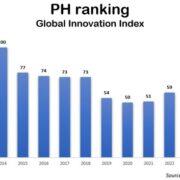The Philippine Manufacturing Purchasing Managers’ Index (PMI) increased from 49.2 last month to 52.5 in January, posting above the 50.0 neutral mark separating expansion from contraction. January PMI data is the highest in 25 months, even prior to the pandemic, signaling improving manufacturing conditions and indicating the start of recovery of the sector.
Manufacturing output increased despite a slight contraction in new export orders. The expansion in manufacturing operations were largely driven by increased orders from existing and new clients, particularly from the domestic market.
Department of Trade and Industry (DTI) Secretary Ramon Lopez stated that, “The latest manufacturing PMI reinforces the importance of our REBUILD economic recovery strategy, which stands for ‘Revitalizing Businesses, Investments, Livelihoods, and Domestic Demand.’ We must continue to build consumer confidence, revitalize domestic demand, and empower manufacturing firms in the country to seize that demand.”
Adjusted for seasonality, PMI’s output index in January recorded the fastest increase in production since June 2019 while increase in new orders index was the fastest since October 2019.
“We are encouraged by the signs of economic recovery that we are seeing, not only in the January manufacturing PMI but also those that point towards longer lasting economic rebound. Clearly, the whole-of-government efforts on the calibrated and safe reopening of the economy was key to this,” Sec. Lopez added.
Board of Investments (BOI)-approved investments for the year were at its 2nd highest. DTI-BOI has launched two (2) important roadmaps in 2020 to support the long-term growth of the country’s manufacturing sector: the Philippine Cold Chain Industry Roadmap and the Leyte Ecological Industrial Zone (LEIZ) Master Development Plan (MDP).
The Cold Chain Industry Roadmap aims to support the COVID-proofing of the country’s food supply systems to ensure food security and other end-user industries such as pharmaceutical industry. The development of LEIZ, on the other hand, is an important pathway towards the rebuilding of the Philippine economy and the realization of the country’s vision to create a modern, dynamic and responsible Philippines.
With the LEIZ, the government hopes to promote industry clustering with a view to reduce logistics costs between integrated businesses and ensure reliable power supply. It is expected to house potential locators in the field of copper wire rod casting, downstream copper industry, copper-using industries, and other possible business activities that will support the economic rehabilitation of typhoon-affected areas.
The LEIZ is also envisioned to be the first ecological industrial zone in the country that embraces the virtues of circular economy and green economy development.
These are complemented by human resource development initiatives, including the DTIJICA (or Japan International Cooperation Agency) Project for Industrial Competitive Enhancement through Industrial Human Resource Development and Supply & Value Chain Development. This initiative aims to strengthen the industrial human resource supporting the local industries by developing improved operational models with the assistance of Japanese technical experts.
The DTI-BOI and the World Bank is also holding a Roundtable Discussion on the Reconfiguration of Global Value Chains (GVCs) in the Philippines on 02 February 2021 to assess the resilience of GVCs in the country, and come up with a strategic approach to rethink, diversify, and redeploy value chains.
Secretary Lopez said that, “We take note of the challenges raised by manufacturing firms, particularly those relating to supply chain disruptions and increasing input prices. We will address these in the Recovery Cluster of the National Task Force, especially in the Task Group on Economic Recovery (TGER) to ensure that we can sustain the expansion of the manufacturing sector in the coming months.”
TGER aims to ensure a post-pandemic recovery and rebuilding through a whole of society approach. TGER is led by DTI with the Departments of Agriculture (DA), Information and Communications Technology (DICT), Interior and the Local Government (DILG), Science and Technology (DOST), Environment and Natural Resources (DENR), Labor and Employment (DOLE), Public Works and Highways (DPWH), Tourism (DOT), and Transportation (DOTr), as well as the Technical Education and Skills Development Authority (TESDA) and the National Economic and Development Authority (NEDA) as members.
The national government agencies involved in TGER are all working closely together to restart and expand economic opportunities, assist the Philippine labor force to be workready and able to adapt to the changing needs of the industries, harness technology to enable continued business operations; and, promote the Philippines as a smart location choice for investments and a safe destination for tourism.
Some of the programs or projects being implemented now are the infrastructure projects under DPWH to improve mobility of goods and people, such as the Roads Leveraging Linkages for Industry and Trade (ROLL-IT) Program. As of now, 533 kilometers of roads leading to industries and trade corridors have been completed. There is also the Luzon Spine Expressway Network Program which once completed will reduce travel time between Ilocos and Bicol from 20 hours to just 9 hours.
Recognizing that innovation is critical in ensuring competitiveness, the DOST has several programs to assist industries and MSMEs by providing technological interventions such as provision of innovation-enabling fund, technology transfer and commercialization assistance, consultancy, technology trainings, and testing and calibration services to empower Micro, Small, and Medium Enterprises (MSMEs) to innovate, move up the technology scale, and become more competitive.
Some of these programs include: the Small Enterprise Technology Upgrading (SETUP) Program, which aims to upgrade the technological capabilities and improve the productivity and efficiency of MSMEs; the Collaborative R&D to Leverage Philippines Economy (CRADLE) Program, wherein assistance is provided to an industry partner with identified problems requiring R&D to be performed by a Higher Education (academe) or the R&D Institution (RDI); and the Business Innovation through S&T (BIST) for Industry Program designed to assist Filipino-owned companies to innovate and develop their competitiveness through acquisition of new and appropriate technologies—hardware or software—for research.
Furthermore, DOLE is providing training and reskilling, livelihood packages and virtual platform for referral and placement for the unemployed.
“These are just a few of the programs being implemented and there are a lot more. What is important here is that the whole-of-society is working with industry, local governments and communities to ensure that businesses do not just survive but continue to be competitive in the long run post pandemic while practicing minimum health standards to prevent the spread of COVID-19.” Sec. Lopez stressed.
He added, “The increase in PMI is a good development and we expect more gains for the economy. We also welcome the UNCTAD report estimating the 30% increase of foreign direct investments (FDI) for the Philippines.”
The UN Conference on Trade and Development’s (UNCTAD) Investment Trends Monitor issued this month showed increase in the preliminary estimates in Philippine FDIs in 2020 even as other countries suffered investment declines.
The trade chief concluded, “Additionally, we are optimistic to see further improvement now that the Congress bicameral committee is set to formally pass the Corporate Recovery and Tax Incentives (CREATE) bill.”
—
Stay updated with news and information from the Department of Trade and Industry by visiting their website at dti.gov.ph.






